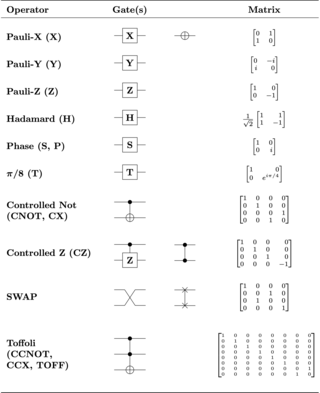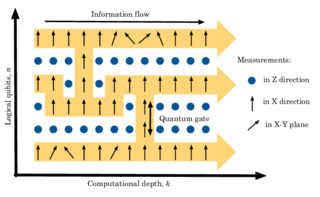Creation of the cluster state
On a silicon photonic chip, one of the most common platforms for implementing LOQC, there are two typical choices for encoding quantum information, though many more options exist. [2] Photons have useful degrees of freedom in the spatial modes of the possible photon paths or in the polarization of the photons themselves. The way in which a cluster state is generated varies with which encoding has been chosen for implementation.
Storing information in the spatial modes of the photon paths is often referred to as dual rail encoding. In a simple case, one might consider the situation where a photon has two possible paths, a horizontal path with creation operator and a vertical path with creation operator , where the logical zero and one states are then represented by
and
- .
Single qubit operations are then performed by beam splitters, which allow manipulation of the relative superposition weights of the modes, and phase shifters, which allow manipulation of the relative phases of the two modes. This type of encoding lends itself to the Nielsen protocol for generating cluster states. In encoding with photon polarization, logical zero and one can be encoded via the horizontal and vertical states of a photon, e.g.
and
- .
Given this encoding, single qubit operations can be performed using waveplates. This encoding can be used with the Browne-Rudolph protocol.
Nielsen protocol
In 2004, Nielsen proposed a protocol to create cluster states, [3] borrowing techniques from the Knill-Laflamme-Milburn protocol (KLM protocol) to probabilistically create controlled-Z connections between qubits which, when performed on a pair of states (normalization being ignored), forms the basis for cluster states. While the KLM protocol requires error correction and a fairly large number of modes in order to get very high probability two-qubit gate, Nielsen's protocol only requires a success probability per gate of greater than one half. Given that the success probability for a connection using ancilla photons is , relaxation of the success probability from nearly one to anything over one half presents a major advantage in resources, as well as simply reducing the number of required elements in the photonic circuit.
To see how Nielsen brought about this improvement, consider the photons being generated for qubits as vertices on a two dimensional grid, and the controlled-Z operations being probabilistically added edges between nearest neighbors. Using results from percolation theory, it can be shown that as long as the probability of adding edges is above a certain threshold, there will exist a complete grid as a sub-graph with near unit probability. Because of this, Nielsen's protocol doesn't rely on every individual connection being successful, just enough of them that the connections between photons allow a grid.
Yoran-Reznik protocol
Among the first proposals of utilizing resource states for optical quantum computing was the Yoran-Reznik protocol in 2003. [4] While the proposed resource in this protocol was not exactly a cluster state, it brought many of the same key concepts to the attention of those considering the possibilities of optical quantum computing and still required connecting multiple separate one-dimensional chains of entangled photons via controlled-Z operations. This protocol is somewhat unique in that it utilizes both the spatial mode degree of freedom along with the polarization degree of freedom to help entanglement between qubits.
Given a horizontal path, denoted by , and a vertical path, denoted by , a 50:50 beam splitter connecting the paths followed by a -phase shifter on path , we can perform the transformations
where denotes a photon with polarization on path . In this way, we have the path of the photon entangled with its polarization. This is sometimes referred to as hyperentanglement, a situation in which the degrees of freedom of a single particle are entangled with each other. This, paired with the Hong-Ou-Mandel effect and projective measurements on the polarization state, can be used to create path entanglement between photons in a linear chain.
These one-dimensional chains of entangled photons still need to be connected via controlled-Z operations, similar to the KLM protocol. These controlled-Z connection s between chains are still probabilistic, relying on measurement dependent teleportation with special resource states. However, due to the fact that this method does not include Fock measurements on the photons being used for computation as the KLM protocol does, the probabilistic nature of implementing controlled-Z operations presents much less of a problem. In fact, as long as connections occur with probability greater than one half, the entanglement present between chains will be enough to perform useful quantum computation, on average.
Browne-Rudolph protocol
An alternative approach to building cluster states that focuses entirely on photon polarization is the Browne-Rudolph protocol. [5] This method rests on performing parity checks on a pair of photons to stitch together already entangled sets of photons, meaning that this protocol requires entangled photon sources. Browne and Rudolph proposed two ways of doing this, called type-I and type-II fusion.
Type-I fusion
In type-I fusion, photons with either vertical or horizontal polarization are injected into modes and , connected by a polarizing beam splitter. Each of the photons sent into this system is part of a Bell pair that this method will try to entangle. Upon passing through the polarizing beam splitter, the two photons will go opposite ways if they have the same polarization or the same way if they have the opposite polarization, e.g.
or
Then on one of these modes, a projective measurement onto the basis is performed. If the measurement is successful, i.e. if it detects anything, then the detected photon is destroyed, but the remaining photons from the Bell pairs become entangled. Failure to detect anything results in an effective loss of the involved photons in a way that breaks any chain of entangled photons they were on. This can make attempting to make connections between already developed chains potentially risky.
Type-II fusion
Type-II fusion works similarly to type-I fusion, with the differences being that a diagonal polarizing beam splitter is used and the pair of photons is measured in the two-qubit Bell basis. A successful measurement here involves measuring the pair to be in a Bell state with no relative phase between the superposition of states (e.g. as opposed to ). This again entangles any two clusters already formed. A failure here performs local complementation on the local subgraph, making an existing chain shorter rather than cutting it in half. In this way, while it requires the use of more qubits in combining entangled resources, the potential loss for attempts to connect two chains together are not as expensive for type-II fusion as they are for type-I fusion.






















































